Flushing – Do You Have Salty Balls?
There’s a big debate among growers about the subject of flushing and whether it is important or not. This debate applies to both mineral feeds and (to a lesser extent) organic feeds.
Why Flush?
According to some, the theory is that as the time draws close to harvest, the plant will have nutrients within itself which have not been used, and that harvesting the plants while still in this state will mean that the taste of them will be present in the final crop. The idea of flushing is to remove any nutrient from the root zone and force the plant to use up the nutrients still inside of it. Further to this, some others believe it is possible by flushing to coax the plant to shed the excess nutrient within itself out through the root zone. While one or both theories may be true to a lesser or greater extent, the advantages of flushing (regularly) actually go much further.
If you have ever grown in clay pebbles with mineral feeds you will probably have noticed that after a while the clay pebbles become lightly coated with a white layer of salt. The clay pebbles are wetted by either a dripper system or a flood and drain system. As the plant draws up water or evaporates, the minerals precipitate out onto the clay pebbles as a fine layer of salt. After a 3-month growing cycle, this fine white layer becomes quite noticeable.
Potential Problems
The roots of plants do not work very well when attached to a substrate containing dried salt. It interferes with their ability to uptake nutrients. This can have a severe impact on yields and final quality.
Apart from pH issues and poor-quality formulations of nutrient, a salty substrate is among the chief causes of plant deficiencies. In fact, if you notice pale leaves or they have spots on them, the first course of action should be to flush the substrate. This cleans the root zone of the salt and gives you a fresh, clean slate to work with.
Afterwards, fresh, pH’d nutrient solution of the correct strength can be applied. Most times this will stop the deficiency from progressing and may even allow the plant to repair some of the damage and get back on track.
Preventative Measures
If you like using preventative measures (and we all do) then it's a great idea to perform a flush every 3-4 weeks. This keeps the substrate salt free and ensures that roots can uptake nutrient trouble-free all the way through the grow. This makes a difference when it comes to maximising your crops. For example, many growers will flush when switching from veg nutrients to bloom nutrients, and then again between about week 4 of flowering. They then often do the last flush a week or two before harvest time.
Flushing Agents
Flushing Agents
Now let’s take a look at whether it’s a good idea to use a flushing agent.
There are two main types. One type uses chemicals to dissolve the salts. The other type relies on the action of chelating agents which lock excess nutrients into solution so that they can be washed out.
Chemical Flushing Agents
Examples of the chemical type dissolve and shift the most stubborn of salts. The chemical types are usually quite harsh and will inevitably all but destroy any beneficial (as well as pathogenic) microbes. This is bad news for organic/biological gardeners. Examples of a chemical flushing agent is Plant Magic Pure Clean.
The good news is that there is little or no salt problem with fully organic feeds such as from Biobizz or Plant Magic Old Timer, so the harsh chemical types shouldn’t really need to be used in this scenario. About the only time that a fully organic gardener should ever need to flush is when they have accidentally overdone the feed strength.
Chelating Agent Type Flushing Agents
Next up is the chelating agent type of flushing agent. The word chelate comes from the Greek work for “claw”. The reason that they use this word is that the chelating compound molecules that are in these agents are literally like molecular claws. Quite often they contain a wetting agent as well to make the agent more effective. The wetting agent helps to dissolve the salts. Then, the chelating molecules grab the dissolved component parts of the salt and hold on to them so that they can then be washed out of the substrate. Good examples of chelating agent type flushes are Plant Magic Flush and Advanced Nutrients Flawless Finish.
In either case, you will want to run lots of water through the substrate after applying the agent to make sure everything is washed out thoroughly.
It's all Good
The good news is that flushing can do a lot of good and not do any harm, even mid-grow, just as long as the nutrient and pH levels are readjusted afterwards. After a good flush, soil/coco will be saturated or even waterlogged. Remember to allow soil or coco to dry out somewhat before watering again, so that oxygen can get to the roots again. Otherwise you could risk root disease.
Hot Tip After Last Flush: After the last flush use a good quality Fulvic Acid supplement such as Vitalink Fulvic. Fulvic Acid helps the plant to shuttle nutrients around the itself to where they can be used. Think of Fulvic Acid as an internal transport system. The better the plant can shuttle nutrients to where they can be used, the less nutrients that will be left in it at harvest time. Another great example of a very high quality Fulvic Acid is New Millenium Ruby Ful #$%

